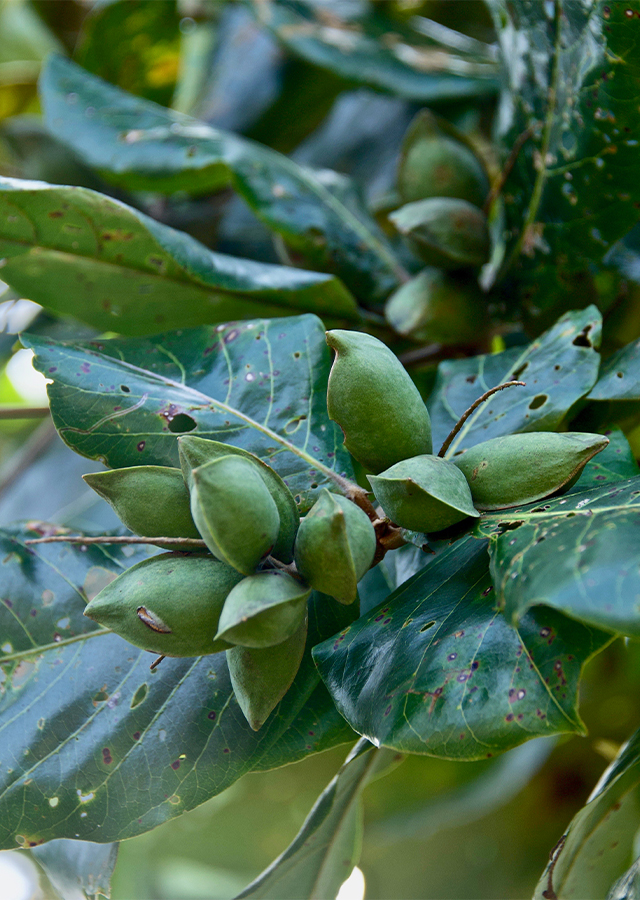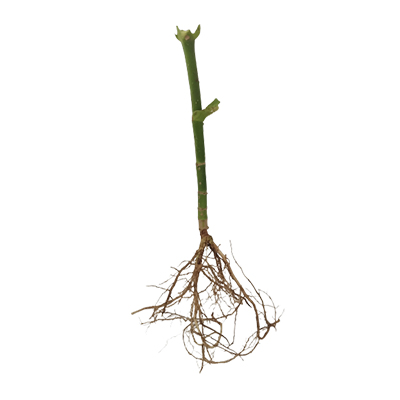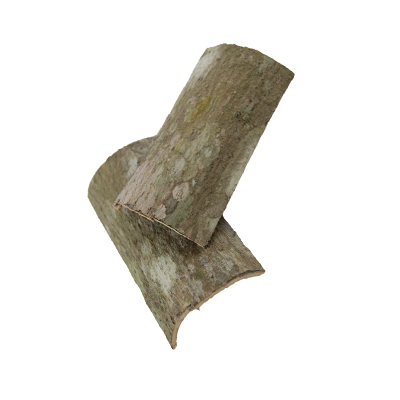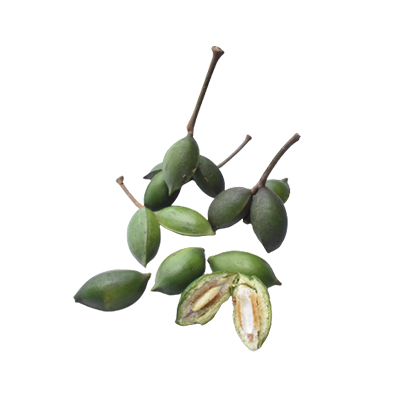Tropical Almond
Terminalia catappa L.
Combretaceae
Location in our garden
Orchard



Synonym
Buceras catappa (L.) Hitchc.
Myrobalanus catappa (L.) Kuntze
Myrobalanus commersonii Kuntze
Habitus
Trees. Semi-evergreen tree, perennial, usually growing about 15 m tall
Part Used
Leaves
Seeds
Bark
Fruit
Roots
Growing Requirements
Full Sunshine
Habitat
Wetland
Coastal
Roadside
Overview
Natural distribution in near coastal areas of the Indian Ocean, through tropical Asia, and into the Pacific Ocean. he species is found throughout the South Pacific region, including the Solomon Islands, Vanuatu, and Fiji.
Vernacular Names
Kotamba (Australia), Amendoeira (Brazil), Lan ren shu (Chinese), Wilde amandel (Dutch), Myrobolan (French), Indischer mandelbaum (German), Castana (Peru).
Agroecology
Plants grow best in the lowland tropics at elevations below 800 m. It grows best in areas where the mean maximum and minimum annual temperatures are within the range 21-32 °C, though it can tolerate 10-36 °C. It prefers a mean annual rainfall in the range 1,500-3,400 mm, though can tolerate from 700-4,200 mm. Prefers a pH in the range 5-7, but tolerates 4.3-8. Succeeds in any moderately fertile, well-drained soil in a sunny position.
Morphology
- Bark - gray to dark gray-brown and shallowly fissured .
- Leaves - arranged in close spirals, often crowded toward the ends of the upturned branchlets. The leaf blade is simple, broadly obovate, 8–38 cm long by 5–19 cm wide. Mature leaves are mostly glabrous (shiny), leathery, and dark green, turning bright yellow then vivid to dark red before falling.
- Flowers - not showy; star-shaped; emerges in terminal clusters on 2″–6″ long racemes, small with color pale green or white, flowering summer and fall.
- Fruits - a sessile, laterally compressed, and ovoid to ovate, smooth-skinned drupe 5–7 cm long and 3–5.5 cm broad, ellipsoid, narrowly winged along lateral margins taste.
- Seeds - cylindrical-oblanceolate, enclosed by the fibrous endocarp.
Cultivation
Propagation by seed - pre-soak for 24 hours in cold water. About 70% of ripe seed germinate in about 20 days.
Chemical Constituents
Flavonoids (vitexin, isovitexin, isoorientin), triterpenoids, alkaloids, apigenin, tannins, saponins, terpenoids, glycosides, anthraquinones.
Traditional Medicinal Uses
- Bark and roots are astringent. They are useful for bilious fever, diarrhoea, as a remedy for sores and abscesses, to treat diabetes, stomach ache, sores, emetic for infants, pimples and fungal skin diseases.
- Studies have shown antioxidant, anti-inflammatory, hepatoprotective, antimicrobial, antimetastatic, analgesic, aphrodisiac, antitumor properties.
- Leaves are sudorific and anthelmintic.
- Bark is used as a diuretic and cardio-tonic in India. Stems and bark, and seeds used for sexual dysfunction in Nigeria, as astringent for gastric ailments, dysentery, for thrush in Indonesia.
- Juice of leaves is used in the preparation of ointment for scabies, leprosy and other cutaneous diseases in India, applied to rheumatic joints, for tonsillitis in Nigeria, for preventing hepatoma and treating hepatitis and for dermatitis in Taiwan.
- The leaves, crushed with Dacrydium elatum and rhizomes of Cyperus rotundus, are combined to treat dysentery, as a vermifuge, while the sap of young leaves, cooked with oil from the kernel, is used to treat leprosy, to treat indigestion, young leaves to cure headaches and colic. The juice of the leaves is ingested for coughs. Leaves, bark and fruit are used to treat yaws.
- Fruit is useful in bronchitis and bowels and for diabetes, bitter, acrid, astringent purgative and aphrodisiac. Kernel of the fruit mixed with beeswax stops putrid exudation and bloody faeces, headache and reduces nausea associated from travelling.
Part Used
Reference Sources
- Fern, Ken. (2019). Useful Tropical Plants Database. Terminalia catappa. http://tropical.theferns.info/viewtropical.php?id=Terminalia%20catappa 19-01-2021.
- Health Benefits Database. (No date). Indian Almonds. Terminalia catappa. https://www.healthbenefitstimes.com/indian-almonds. 19-01-2021.
- Lim, T.K. (2016). Edible Medicinal and Non-Medicinal Plants. New York. Springer, v.2.p.143.
- StuartXchange. (2018). Philippine Medicinal Plants. Terminalia catappa. http://www.stuartxchange.com/Talisay.html. 19-01-2021.



